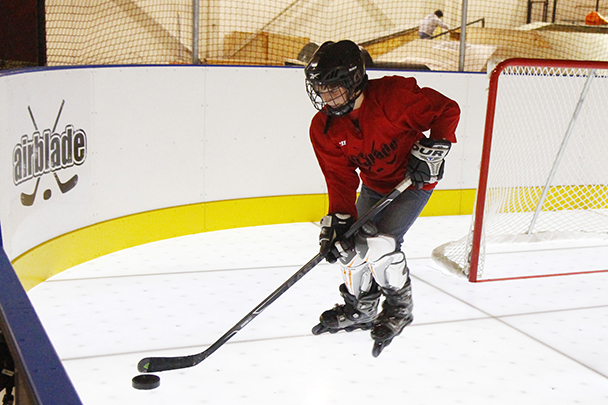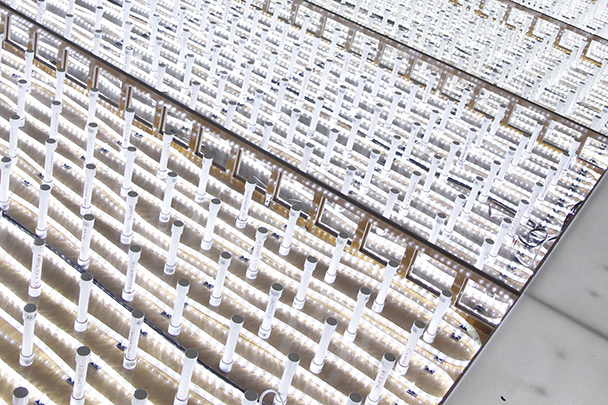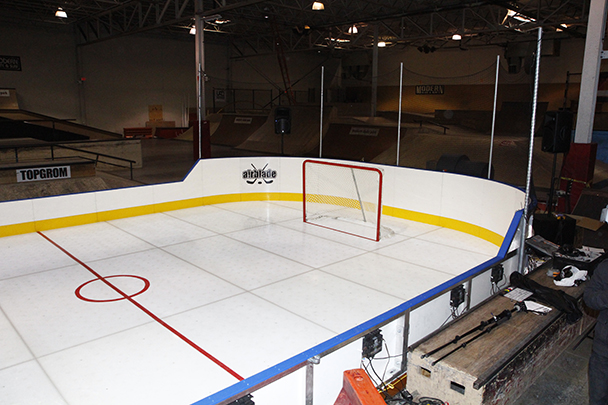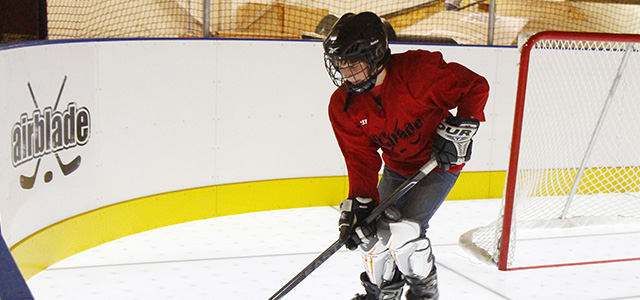Airblade aims to mix air hockey and real hockey into new extreme sport

By Michael Caples –
Air hockey meets real hockey.
That’s how the creators of Airblade – a new twist on hockey – are explaining it.
It seems to be the appropriate explanation for it, too, since they are literally creating a life-sized air hockey rink for players to compete on.
Started right here in Michigan, Airblade aims to speed up the puck and increase the excitement in a unique new way. Founder and CEO Mark Sendo has taken his idea of mashing air hockey and real hockey from an idea to prototypes and testing and, soon, legitimate competition.
“So many people just really enjoy air hockey itself, for a variety of reasons,” Sendo said in an exclusive interview with MiHockey. “We were talking about, what if it was made bigger? The first question of, could it even be done?
“I’m telling you, you have no idea about the engineering. We’ve talked to engineers from the University of Michigan, professors in fluid mechanics, mechanical engineering, architecture – we’ve talked to so many people to help design this system to push enough air pressure to float a puck that’s playable for adults and kids. In terms of the engineering, that was quite a big challenge – it probably took six to nine months alone.”
What has resulted from that research is a new hockey hybrid. A full Airblade Extreme Hockey court features 14 commercial-grade blowers and a larger, flatter puck that will allow for passes and shots to fly around the playing surface at a much faster rate than ice or roller hockey. An Airblade playing surface will also have 6-foot banks at each ends of the ‘ice’ to create a halfpipe-like feel, increasing speed of play. Plus, there are LED lights in the floor, speakers in the boards and two-point slots in the nets for players to target for increased points totals.

The AirBlade Extreme Pro Rink will measure in at the same size of a traditional NHL ice rink – 85 feet by 200 feet. More than two million perforated holes will allow the blowers to create a real-life air hockey element of speed for the flattened puck. It will take two megawatts to power the blowers and the LED lights, the latter of which will use lights to follow the puck, highlight players and power messaging and sponsorships on the playing surface.
“This is how we have it envisioned in a stadium setting – the stadium’s completely dark, you turn on the blowers one at a time, there should be about 14 commercial sized blowers surrounding the rink, then you turn on the LED lights, and it just lights up the entire stadium, because one megawatt of electricity is required to power the lights alone,” Sendo said. “Then the players come out and, you know, it should be something nobody has ever seen before. It’s going to be amazing.”
Feel the need to see the new sport live to full understand it? Sendo and co-founders Fred Beal, Brian Barr and Alaina Blake have lined up their first big tournament – at Ford Field. The home of the Detroit Lions will host the first AirBlade Extreme Hockey championship tournament from May 23-25 in Detroit. An eight-team field will participate in a single-elimination tournament, and prior to the championship game, an alumni game featuring Red Wings alums Joey Kocur, Darren McCarty and Petr Klima will take place.
Yet while they are coordinating an event inside a professional football field, Sendo has plans for Airblade to also be available to athletes of all skillsets and ages.
“We also envision having this for the backyard,” Sendo said. ‘The very first vision was going out into my backyard, plugging in my iPod because there are speakers in the dasher boards, turn on the blowers and turn on the lights, and I’m playing hockey in Los Angeles in the middle of the night in 80-degree weather.
“I think if we can get the engineering done to get the price point down, this could be in millions of homes across the country.”

Sendo and his team have been working with Michigan-based JC Beal Construction to build the prototypes. The first one started as a desktop model, and the second one – at 24-feet by 40-feet – is currently being reconstructed at Perani’s Hockey World in Livonia for people to try it out.
“When I just had it on a piece of paper, we built a tabletop prototype,” Sendo said. “I found a guy who played hockey for 15 years and was a builder, he was really instrumental in developing the first prototype. Three quarter-inch polycarbonate surface, holes were drilled one inch on center, we had a standard blower, I don’t know what the size of it was, it was a small blower. When we did the testing of it, it worked, and that’s when I brought in JC Beal which has been around for 51 years, they are solid builders, they set us on the path to get the engineering for the bigger prototype, which was 24 x 40, cost about $250,000. We did everything the right way, we had to make sure that it worked.”
The Airblade project is currently on crowd-sourced fundraising site Kickstarter for five more days. Sendo said that while it hasn’t pulled the amount of money listed as the fundraising goal, Kickstarter served as a platform to start their social media campaign of raising awareness for the new sport. At this point, they are looking for private investors to help with the growth of Airblade.
Sendo is confident that his idea, first crafted in 1999, will stick.
“I see it going two ways, one is that we hope to have four tournaments this year to get rapid adoption of this new fast-paced sport. Once we get that, we want to actually form a league and sell franchises to start a league. Number 2, we want to manufacture the mini rinks for UAC juniors and putting these in cities around the country, for the kids and start creating kids leagues and stuff like that.
“It’s a big undertaking, that’s for sure.”

